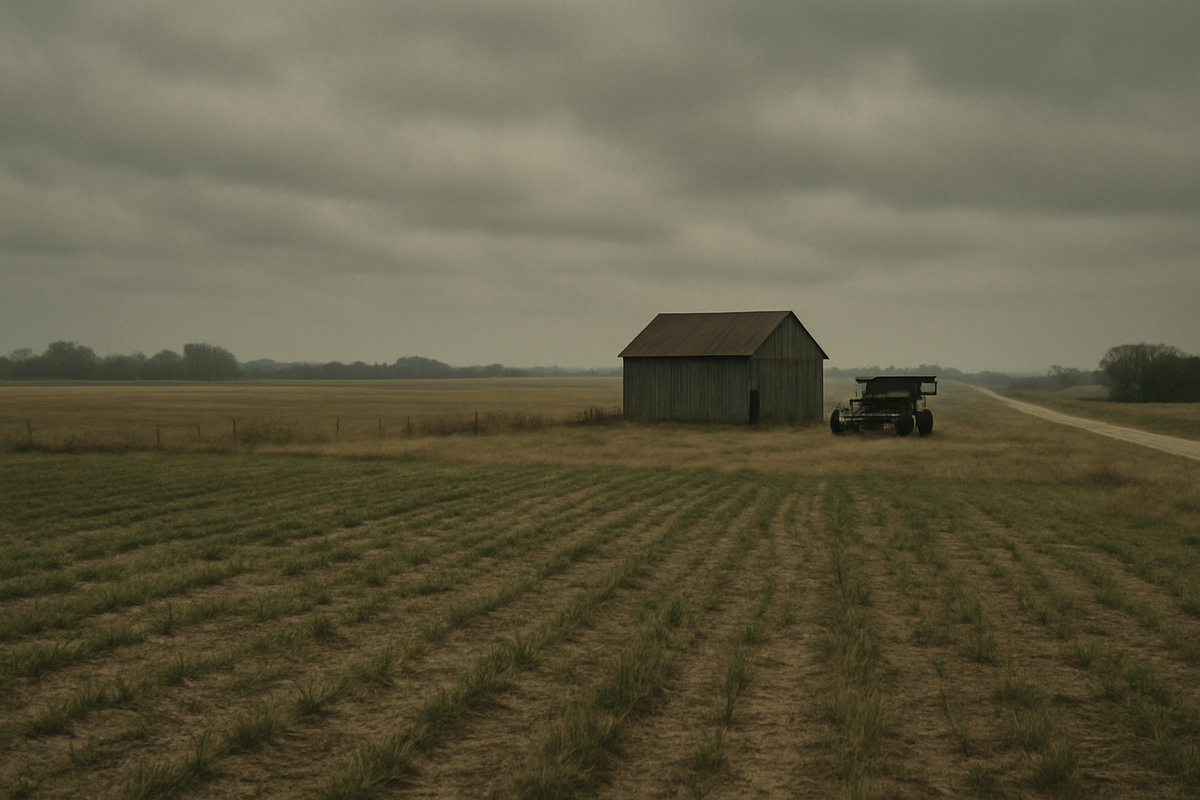
The backbone of America's heartland is showing significant strain as a key indicator of rural economic health has plunged to its lowest point in five years. As of October 2025, the Creighton University Rural Mainstreet Index (RMI), which surveys rural bank CEOs across a 10-state agricultural region, registered a concerning 34.6. This figure, marking its lowest since May 2020, signals a deepening contraction in the rural economy, casting a long shadow over agricultural commodity markets and the broader economic landscape of farming communities.
This sharp decline reflects a confluence of factors, including persistent weak commodity prices for staple crops, stubbornly high input costs, and a dramatic reduction in agricultural exports. The immediate implications are severe: farmers face negative cash flows, rural businesses are struggling, and the financial stability of regional banks is increasingly under pressure. This downturn not only threatens the livelihoods of millions but also raises concerns about food production stability and the long-term viability of traditional farming practices.
Unpacking the Crisis: Details, Timeline, and Initial Reactions
The rural economic downturn has been a developing story throughout late 2024 and 2025, with multiple indicators confirming a challenging environment. The Creighton University Rural Mainstreet Index, a bellwether for the agricultural sector, has remained below the growth-neutral threshold of 50.0 for eight months in 2025 alone, culminating in its five-year low in October. This sustained contraction points to deep-seated issues rather than a fleeting blip.
Specific details from the RMI paint a grim picture: farmland prices have been below growth neutral for 17 of the past 18 months, reflecting eroding confidence in agricultural asset values. Farm equipment sales, a key indicator of capital investment and farmer optimism, have been in a prolonged slump for an alarming 26 consecutive months. Furthermore, farm loan delinquency rates have risen from 1.1% in June 2025 to 1.6% in October 2025, signaling increased financial distress among producers. The situation is exacerbated by a staggering 85.7% plummet in regional agricultural and livestock exports to China during the first seven months of 2025 compared to the same period last year, highlighting the profound impact of geopolitical tensions and trade policies.
Other key players and stakeholders, including the Purdue University/CME Group Ag Economy Barometer, also confirm the trend. Its September 2025 "Index of Current Conditions" fell seven points to 122, and the "Farm Financial Performance Index" dropped to 88, indicating weaker immediate circumstances and declining financial outlooks for farmers. CoBank's 2025 Year Ahead Report, issued in December 2024, had already warned of a "volatile and uncertain" outlook, noting row crop prices were down nearly 50% from 2022 highs while production costs remained elevated, leading to "decade-plus lows" in profitability. Federal Reserve Bank reports from Q2 2025 further underscored the crisis, with 81% of agricultural lenders reporting decreased farm incomes and 69% noting reduced capital expenditures. Initial market reactions have been characterized by sustained downward pressure on commodity prices, a tightening of credit conditions in rural banking, and a visible pullback in farm-related investments.
Corporate Fortunes in the Balance: Winners and Losers
The widespread economic contraction in rural America has direct implications for a range of public companies, creating both significant challenges and, in some nuanced cases, unexpected opportunities. The most immediate and profound losers are those deeply entrenched in the agricultural supply chain and rural finance.
Agricultural machinery manufacturers, such as Deere & Company (NYSE: DE), are facing substantial headwinds. With farm equipment sales in a prolonged slump for over two years, demand for new tractors, combines, and other machinery has plummeted. This directly impacts their sales volumes and profitability, potentially leading to reduced production, layoffs, and a reevaluation of future investment in research and development. Similarly, companies that produce agricultural inputs like fertilizers, seeds, and crop protection chemicals are feeling the pinch. Corteva, Inc. (NYSE: CTVA) and Nutrien Ltd. (NYSE: NTR), key players in these sectors, are likely experiencing reduced demand as farmers cut back on discretionary spending and optimize input usage to cope with tight margins. Their revenues are directly tied to farmer profitability and willingness to invest in yield-enhancing products.
Rural banks and agricultural lenders, while often privately held or regional, are also significant losers. Publicly traded regional banks with substantial agricultural loan portfolios could see increased loan delinquencies and charge-offs, impacting their financial health. The rise in farm loan delinquency rates is a clear indicator of this stress. Conversely, while direct "winners" are harder to identify in a widespread downturn, some entities might experience indirect benefits or prove more resilient. Food processing companies, for instance, could potentially benefit from lower raw material costs if commodity prices remain depressed. However, this benefit is often tempered by eventual supply disruptions if farmer financial stress leads to reduced planting or farm exits. Additionally, companies specializing in agricultural technology that offers significant cost savings or efficiency gains might find a market, even if overall capital investment is down, as farmers look for ways to do more with less.
Broader Significance: Trends, Ripple Effects, and Historical Echoes
The current rural economic crisis is not an isolated event but rather a symptom of deeper, evolving trends within the agricultural sector and the global economy. It highlights the increasing vulnerability of a sector heavily exposed to volatile commodity prices, geopolitical trade disputes, and the inexorable rise of input costs. This event fits into a broader industry trend of consolidation, where smaller, less capitalized farms struggle to compete, potentially leading to a further concentration of agricultural production in larger, more efficient operations. The reliance on advanced agricultural technology and precision farming, while offering efficiency, also requires significant capital investment, creating a barrier to entry and a challenge for struggling farmers.
The ripple effects of this downturn extend far beyond the farm gate. Local rural economies, heavily dependent on agricultural spending, face widespread hardship. Businesses ranging from equipment dealerships to local hardware stores, restaurants, and service providers experience reduced demand, leading to job losses and further economic contraction. This can exacerbate rural depopulation and strain social services. On a national scale, sustained agricultural distress can eventually impact food supply chains and consumer prices, though the immediate effect is often more localized. Policy implications are significant, with mounting pressure on governments to provide financial aid and stabilize the sector. The substantial increase in federal disaster aid and direct government payments driving net farm income projections for 2025 underscores this reliance, masking underlying structural weaknesses.
Historically, this period draws parallels to past farm crises, particularly the devastating 1980s, when a combination of high interest rates, low commodity prices, and a strong dollar led to widespread farm bankruptcies and rural economic collapse. While the current situation has different drivers, the fundamental challenge of profitability under adverse market conditions resonates. The ongoing trade tensions, particularly with China, add a layer of complexity not seen in previous crises, transforming what might have been a cyclical downturn into a more structural challenge for American agriculture.
The Road Ahead: Navigating Uncertainty
The path forward for the rural economy and agricultural markets is fraught with both challenges and potential for strategic adaptation. In the short term, continued financial strain is inevitable. Expect to see a further increase in farm loan delinquencies and potentially a rise in farm bankruptcies as producers grapple with negative cash flows. This will likely intensify calls for more robust government intervention, including expanded aid programs, commodity price supports, and efforts to resolve trade disputes that are stifling agricultural exports. The upcoming months will be critical for policymakers to assess the extent of the damage and formulate effective responses.
Longer term, this crisis could accelerate structural changes within American agriculture. We may see further consolidation of farms, with larger operations leveraging economies of scale and advanced technology to weather the storm. There could also be a strategic pivot towards more diversified farming practices, value-added products, and niche markets less exposed to global commodity price fluctuations. Innovation in areas like sustainable farming, drought-resistant crops, and alternative energy sources for farm operations might gain traction as producers seek to reduce input costs and increase resilience.
Market opportunities, while scarce in the immediate term, could emerge for companies offering solutions that significantly reduce costs, improve efficiency, or provide new revenue streams for farmers. Challenges will remain for traditional commodity producers reliant on export markets and favorable weather conditions. Potential scenarios range from a gradual, policy-supported recovery, where targeted aid and improved trade relations slowly lift the sector, to a prolonged downturn if commodity prices remain stubbornly low and input costs continue to rise, leading to more widespread farm exits and a fundamental reshaping of the agricultural landscape.
Wrap-Up: A Resilient Sector Under Pressure
The sinking of the rural economy indicator to a five-year low is a stark reminder of the immense pressures currently facing America's agricultural heartland. Key takeaways include the critical impact of weak commodity prices, elevated input costs, and decimated export markets on farmer profitability and rural economic vitality. The reliance on government support, while providing a temporary buffer, underscores the fragility of the current market conditions.
Moving forward, the market will remain highly sensitive to global commodity price movements, the trajectory of input costs (especially fuel and fertilizer), and the evolution of international trade policies. Investors should closely monitor government agricultural policy announcements, particularly regarding direct payments and export initiatives. The health of rural banks and their loan portfolios will also be a crucial indicator of the sector's overall financial stability. The resilience of the agricultural sector is legendary, but the current confluence of challenges tests even the most seasoned producers. The lasting impact of this downturn will likely be a more consolidated, technologically driven, and potentially government-dependent agricultural industry, prompting a fundamental rethinking of how America supports its farmers and ensures its food security.
This content is intended for informational purposes only and is not financial advice






